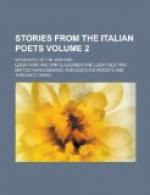Thebais, x. 414.]
[Footnote 15: This adventure of Cloridan and Medoro is imitated from the Nisus and Euryalus of Virgil. An Italian critic, quoted by Panizzi, says, that the way in which Cloridan exposes himself to the enemy is inferior to the Latin poet’s famous
“Me, me (adsum qui feci), in me convertite ferrum.”
Me, me (’tis I who did the deed), slay me.
And the reader will agree with Panizzi, that he is right. The circumstance, also, of Euryalus’s bequeathing his aged mother to the care of his prince, in case he fails in his enterprise, is very touching; and the main honour, both of the invention of the whole episode and its particulars, remains with Virgil. On the other hand, the enterprise of the friends in the Italian poet, which is that of burying their dead master, and not merely of communicating with an absent general, is more affecting, though it may be less patriotic; the inability of Zerbino to kill him, when he looked on his face, is extremely so; and, as Panizzi has shewn, the adventure is made of importance to the whole story of the poem, and is not simply an episode, like that in the AEneid. It serves, too, in a very particular manner to introduce Medoro worthily to the affection of Angelica; for, mere female though she be, we should hardly have gone along with her passion as we do, in a poem of any seriousness, had it been founded merely on his beauty.]
[Footnote 16: Canto xix. st. 34, &c. All the world have felt this to be a true picture of first love. The inscription may be said to be that of every other pair of lovers that ever existed, who knew how to write their names. How musical, too, are the words “Angelica and Medoro!” Boiardo invented the one; Ariosto found the match for it. One has no end to the pleasure of repeating them. All hail to the moment when I first became aware of their existence, more than fifty years ago, in the house of the gentle artist Benjamin West! (Let the reader indulge me with this recollection.) I sighed with pleasure to look on them at that time; I sigh now, with far more pleasure than pain, to look back on them, for they never come across me but with delight; and poetry is a world in which nothing beautiful ever thoroughly forsakes us.]
[Footnote 17:
“Scritti, qual con carbone e qual con gesso.”
Canto xxiii. st. 106.
Ariosto did not mind soiling the beautiful fingers of Angelica with coal and chalk. He knew that Love did not mind it.
* * * * *
ASTOLFO’S JOURNEY TO THE MOON.
Argument.
The Paladin Astolfo ascends on the hippogriff to the top of one of the mountains at the source of the Nile, called the Mountains of the Moon, where he discovers the Terrestrial Paradise, and is welcomed by St. John the Evangelist. The Evangelist then conveys him to the Moon itself, where he is shewn all the things that have been lost on earth, among which is the Reason of Orlando, who had been deprived of it for loving a Pagan beauty. Astolfo is favoured with a singular discourse by the Apostle, and is then presented with a vial containing the Reason of his great brother Paladin, which he conveys to earth.




